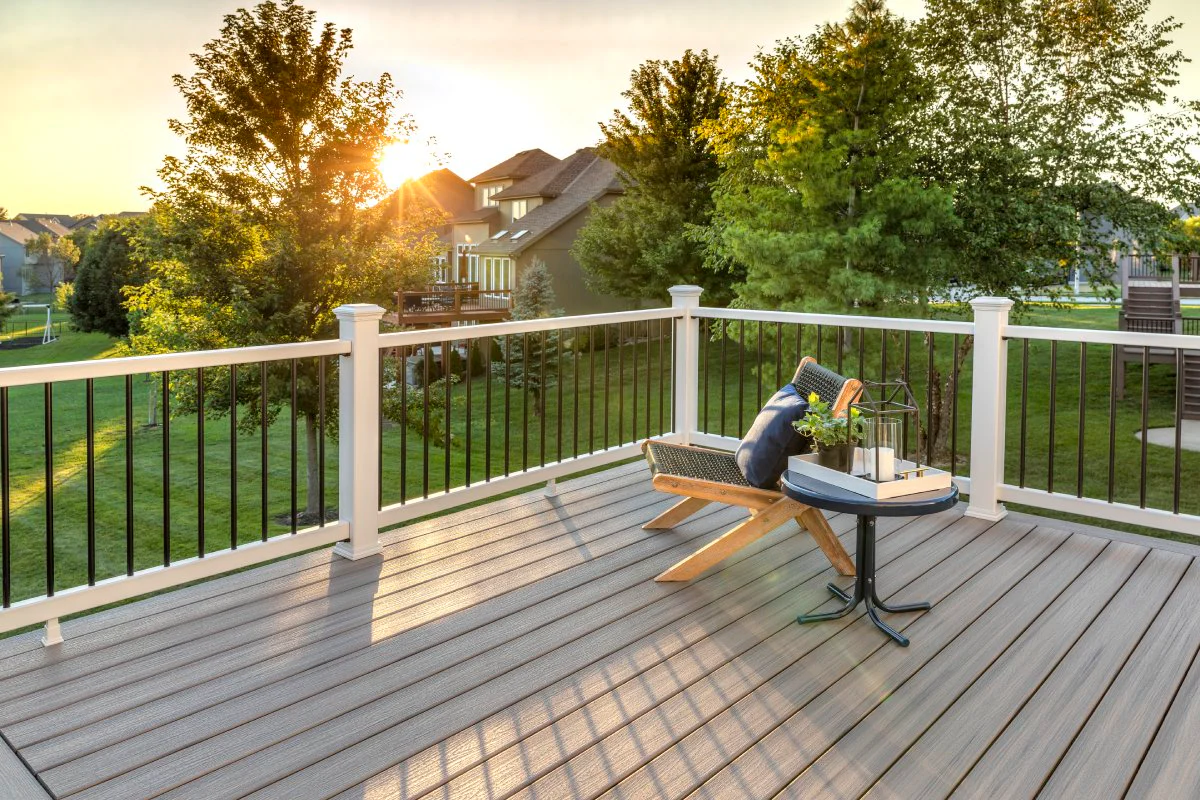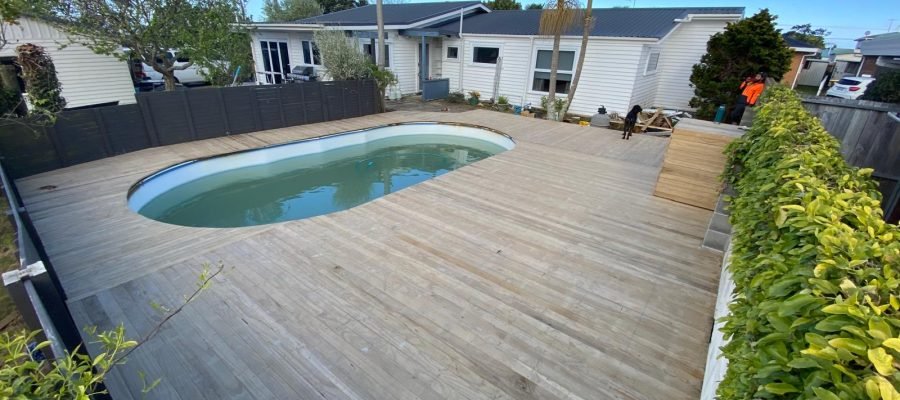How to Clean Decking Naturally: Eco-Friendly…
Discover how to clean decking naturally in Auckland. Use DIY solutions like vinegar & baking…
Building a deck is one of the best ways to enhance your Auckland home, creating a seamless transition between indoor and outdoor living spaces. Whether you’re dreaming of a ground-level patio for summer barbecues or a raised deck to capture panoramic views of the Waitematā Harbour, one key question arises: “How high can you build decking?” The answer isn’t just about aesthetics—it involves navigating New Zealand’s building regulations, ensuring safety, and designing a deck that suits your lifestyle while standing the test of time. In Auckland, where sloping sections, multi-level homes, and strict council rules are common, understanding deck height limits is crucial to avoid fines, safety hazards, or costly rebuilds. This comprehensive guide will walk you through NZ’s decking height regulations, key design and structural considerations, and when to call in a professional to ensure compliance. For complex projects or to guarantee your deck meets all requirements, My Homes Decking Experts in Auckland is here to help you create a safe, stunning outdoor space that enhances your home for years to come.

Before diving into the specifics of deck height regulations, it’s worth understanding why height matters in the first place. A deck’s height impacts more than just its appearance—it affects safety, compliance, and how well it integrates with your property. Here’s why getting the height right is essential for Auckland homeowners:
Getting the height of your deck right ensures it’s safe, functional, and compliant, allowing you to enjoy your outdoor space without worry. Whether you’re a DIY enthusiast or planning a larger project, understanding these factors will set you up for success.
In New Zealand, the maximum height you can build a deck without needing a building consent is governed by the NZ Building Code, specifically Schedule 1 of the Building Act 2004, as well as local council rules. Auckland Council may also impose additional requirements based on zoning or environmental factors. Here’s a detailed breakdown of the rules:
Compliance Tip: Always check with Auckland Council before starting your project, even for decks under 1.5m, to ensure you’re not overlooking local zoning rules, overlays, or environmental factors like flood zones or protected trees.
Understanding these height thresholds ensures your deck is both safe and legal, avoiding fines, delays, or the need to dismantle non-compliant structures. For decks close to the 1.5m limit, it’s wise to consult a professional to confirm compliance.

The height of your deck isn’t solely determined by regulations—it’s also influenced by practical, design, and environmental factors. Auckland’s diverse terrain and housing styles add complexity to these decisions. Here’s a detailed look at the factors that impact deck height:
Design Suggestion: Consider a multi-level deck design to work with a sloping section—lower levels can stay under 1.5m to avoid consents, while higher levels can be strategically placed for views or functionality.
By considering these factors, you can plan a deck that’s both practical and compliant, tailored to your Auckland property’s unique characteristics and your lifestyle needs.
Building a deck over 1.5 metres in height comes with additional regulatory requirements in New Zealand, particularly in Auckland, where local rules can add complexity. Here’s a detailed look at when you’ll need a building consent and what to consider for elevated decks:
Council Tip: Engage with Auckland Council early in the planning process to clarify requirements, especially if your property is in a special zone or has environmental constraints. This can save time and prevent costly delays.
Navigating these requirements can be daunting, but they’re essential to ensure your deck is safe, legal, and doesn’t cause disputes with neighbours or the council. For complex projects, a professional can streamline the consent process and ensure compliance.
Building a deck at any height requires careful attention to safety and structural integrity, but this becomes even more critical for elevated decks. Auckland’s climate, terrain, and regulatory environment add extra layers of complexity. Here’s a detailed look at the safety and structural requirements you need to consider:
Safety Warning: DIY builds can be risky if you’re not familiar with structural requirements. Overlooking proper footings, bracing, or balustrades can lead to deck collapse or falls, posing a serious safety hazard. Always consult a professional for decks over 1.5m or in complex terrain.
Ensuring your deck meets these safety and structural requirements will keep it stable, safe, and compliant with NZ regulations, giving you peace of mind for years of enjoyment.
While small, ground-level decks can often be a DIY project, elevated or complex decks are best left to professionals, especially in Auckland where regulations, terrain, and climate add complexity to the build. Here’s when to call in the experts:
My Homes Decking Experts specialises in creating safe, compliant, and beautiful decks across Auckland, from simple patios in flat suburbs like Papatoetoe to elevated entertainment spaces in hilly areas like Titirangi. Their team can guide you through the entire process, from design to council approval to construction.
Ready to build your dream deck? My Homes Decking Experts is here to help Auckland homeowners create stunning, safe, and compliant outdoor spaces. Whether you’re planning a ground-level patio in Howick, a poolside deck in St Heliers, or a raised viewing platform in Devonport, our experienced team has the expertise to bring your vision to life while navigating all council requirements.
📞 Call the My Homes Decking Experts: 022 315 8987
📧 Email: info@myhomesconstruct.co.nz
🌐 Website: https://deckingexpert.co.nz
From design to completion, we’re Auckland’s decking pros—contact us today for a free consultation and let us transform your outdoor space!
Do I need council approval for a raised deck in Auckland?
Yes, if your deck is over 1.5m above ground level, you’ll need a building consent from Auckland Council. Additional resource consents may apply if the deck affects privacy, drainage, or special zones like heritage areas.
What happens if my deck is too high without consent?
Building a deck over 1.5m without a consent can result in fines from Auckland Council (up to $1,000), and you may be required to dismantle it. Non-compliant decks can also cause issues with property sales or insurance claims.
Can I build a deck on a slope without extra supports?
No, decks on sloped sections—like those common in Titirangi or the Waitakere Ranges—require deeper footings, taller posts, and bracing to ensure stability. A professional can design a safe solution tailored to your property.
How high should a balustrade be on a raised deck?
For decks over 1m above ground, the NZ Building Code requires a balustrade at least 1m high with gaps no wider than 100mm to ensure safety, especially for children.
What materials are best for a raised deck in Auckland?
Treated timber (H3.2 or higher for above-ground use, H4 for ground contact) or composite decking with galvanised fixings are ideal for Auckland’s wet and salty climate, ensuring durability against rot and corrosion.
How much does a building consent cost for a raised deck in Auckland?
Building consent fees typically range from $1,000 to $3,000, depending on the project’s complexity. Additional costs may apply for engineering reports or resource consents.
Can I build a deck over a protected tree in Auckland?
No, building near or over a protected tree requires a resource consent from Auckland Council. This is common in areas like Titirangi, where native trees are often protected.
How long does it take to get a building consent for a deck in Auckland?
The process typically takes 20 working days, but it can take longer if your application is incomplete or requires additional consents (e.g., resource consent for a heritage area).
Building a deck at the right height is a balance of design, safety, and compliance, ensuring your outdoor space enhances your Auckland home without compromising on safety or legality. By understanding NZ’s decking height regulations—such as the 1.5m consent threshold—and considering factors like land slope, intended use, and structural requirements, you can create a deck that’s both beautiful and practical. Proper footings, bracing, and balustrades are essential for elevated decks, particularly in Auckland’s challenging terrain and climate. While decks under 1.5m may be suitable for a DIY approach, elevated or complex designs are best handled by professionals who can navigate Auckland Council rules, ensure safety, and deliver a long-lasting result.
My Homes Decking Experts is here to help Auckland homeowners build smart, safe, and stunning decks, whether you’re in a flat suburb like Papatoetoe, a hilly area like Titirangi, or a coastal spot like Devonport. From design to council approval to construction, our team is ready to bring your vision to life. Call us at 022 315 8987, email info@myhomesconstruct.co.nz, or visit https://deckingexpert.co.nz to schedule a free consultation today. Let us turn your outdoor dreams into a reality—safely, compliantly, and beautifully!
Discover how to clean decking naturally in Auckland. Use DIY solutions like vinegar & baking…
Kwila Decking for Auckland Homeowners How Long Does Kwila Decking Last? A Comprehensive Guide for…
How to Build a Deck: A Comprehensive Step-by-Step Guide Introduction Did you know that adding…